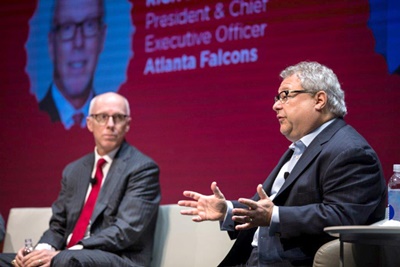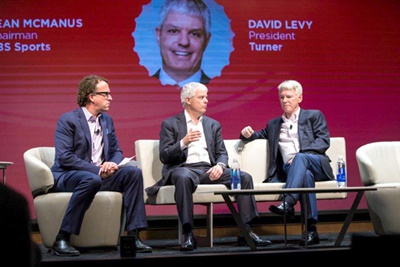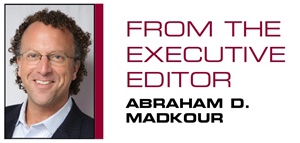I’ve been fortunate to visit and write about a number of exciting development projects in sports, and I’ll add what the Bucks are doing in Milwaukee to that list. I visited the city for the first time earlier this month and while there I was able to sit with the Bucks’ leadership and see their plans for a $524 million arena and parking structure that are scheduled to be complete by the fall of 2018. It’s an ambitiously timed project, and groundbreaking is scheduled for next month.
But in meeting with owner Marc Lasry, minority partner Jamie Dinan and team President Peter Feigin, a few things stood out about what the team is looking to accomplish in the market and the challenges the Bucks face.
 |
FEIGIN
|
 |
LASRY
|
First, this leadership group is not from Milwaukee, and while many out-of-town ownership groups fail to connect to a local, close-knit community, I didn’t get that sense from this group. Feigin, in particular, has done a remarkable job of embedding himself in the business sector, and his New York-based mix of humor, personality and persistence has played well in the Midwest market. Throughout the city, he was lauded for his efforts in getting the arena deal done, enhancing the visibility of the team and driving community involvement. The team’s business metrics have improved, and there is a vibe that this is an aggressive organization willing to try new things and take risks.
Walking through the Bucks’ loft-like executive office, you get a sense by the increased head count that the team is exploiting all of its assets and content. This is a far more difficult culture than the one under the previous ownership of Herb Kohl, who is one of the great benefactors of Milwaukee. But this team has a noticeably more progressive, forward-thinking and fast-moving approach.
 |
Plans for the Milwaukee Bucks’ new arena include outdoor plazas and room for mixed-use development.
Photo by: COURTESY OF THE MILWAUKEE BUCKS
|
Sitting with Lasry and Dinan on a panel by our sister publication, the Milwaukee Business Journal, the two connected with the business community and stressed the growth prospects around the downtown development. The two were honest — both agreed the basketball business is more difficult and complicated than anticipated — and they acknowledged mistakes in rushing player personnel decisions. While admittedly not in town frequently, both said the right things and their vision for downtown has the potential to remake Milwaukee.
If you haven’t had a chance, check out the fantastic-looking renderings of the building from architect Populous. You will see a facility that is walkable from downtown, featuring open, airy plazas for community gathering. The team also will embark on a projected $400 million to $500 million in mixed-use projects around the arena.
On the court, the team has significant work to do. It struggled this year after making the playoffs last year. But off the court, despite a time when the future of the team in the city looked in peril, the work of ownership and Feigin has secured it for years to come and made the Bucks a key architect in the future success of Milwaukee.
> FROM THE ROAD: Going through my notes after hitting Milwaukee, Atlanta and Los Angeles for various events:
■
SCHEDULING: It’s a consistent answer I’ve received when asking team leaders what aspect they would change about their sport. The Bucks’ Lasry talked about extending the NBA season to give players more time to recover from injuries and offer more rest between games. I also found the comments from Brewers COO Rick Schlesinger interesting. “I think 162 games in 183 days is insanity. If you were inventing baseball [today] … you clearly would have fewer games,” he said. “To me, if you went to 154 games and have Monday as a normal day off, I think the sport is healthier. The [star] players would play more games. Most teams would be glad to give up Monday [home games].”
I don’t think any MLB teams would mind giving up the soft attendance of a Monday. But despite this interest, I’d be very surprised if fewer games trump the economic incentive for owners to keep the schedule as is during MLB’s next CBA negotiations.
 |
Falcons CEO Rich McKay and Hawks CEO Steve Koonin both said brands, teams and leagues should use players more often for storytelling and promotions.
Photo by: KELLY KLINE
|
■
RAPID-FIRE QUESTIONS: It was good to be with my colleague Ben Fischer at the Coca-Cola Sports Summit over two days in Atlanta. The brand brought in nearly 500 of its top partners, customers, bottlers, agencies and other business lines for discussions about trends in sports and best practices where brands can use the power of sports as a marketing vehicle. It also included appearances by Coca-Cola brand Olympic endorsers and great remarks from four-time gold medal winner
Janet Evans about her history with the Olympic movement.
It was great to see so many colleagues, and I always have time for Atlanta Hawks CEO Steve Koonin and Falcons President and CEO Rich McKay, and I asked them what they felt were the most underutilized assets of their game: Could it be a league asset or team/venue asset? Both were quick with the same answer: players. Both feel their players should be utilized more by brands, teams and leagues to get positive promotional messaging out and for storytelling. When I asked them what they would change about their respective sports, Koonin was quick to reply, “Legalize gambling.” Meanwhile, McKay drew on his history when it comes to stadium development in saying, “I wish we could solve our stadium problems in a less contentious fashion when it comes to the public discourse.”
■
THE REALITY OF VR: A couple of Koonin gems. Asked if he was looking at any technology to improve the tailgating experience for Hawks fans, he didn’t miss a beat: “Tailgating is French for loitering. Get your butts into our arena.” Koonin also is not as bullish as many on virtual reality, throwing some cold water on the new tech. “It’s heavy, it’s clunky,” he said. “There are all sorts of rights issues. I think it’s a long ways away.” Asked about major obstacles to consumer adoption, he said, “Besides throwing up?”
 |
The Olympics and the sale of the UFC were topics for Turner’s David Levy and CBS’s Sean McManus on a discussion moderated by SBJ/SBD’s Abraham Madkour.
Photo by: KELLY KLINE
|
On a separate panel, ESPN’s
John Skipper agreed, believing that the at-home experience is so strong with the current broadcast technology that, “Its not like it’s a particularly unhappy experience.” Skipper added, “We’re not quite as bullish on VR. … It’s a wow factor, but I can’t wait to take them off.”
■
QUICK HITS: CBS Sports President Sean McManus, on the sudden collapse of Jordan Spieth at the Masters, which McManus witnessed from the production truck in Augusta: “That was as dramatic and as stunning a half hour as you’re ever going to see on TV,” he said. Asked about the NFL’s return to Los Angeles after a 20-year absence, he said, “I think it’s going to be very successful.” Finally, the story in sports business he is watching most closely in the next year: “How successful are the Olympics going to be in Rio? That’s going to be a very interesting story to follow. What is going to be the future of Olympics both on TV and on site?” Meanwhile, Turner Sports’ President David Levy’s top story? “Who buys the UFC?” he said.
Let’s end with this: Skipper was asked what he looks for in a new hire. “Brains,” he said. “Experience can be overrated in a new hire. I look quickly for brains.”
Abraham D. Madkour can be reached at amadkour@sportsbusinessjournal.com.









